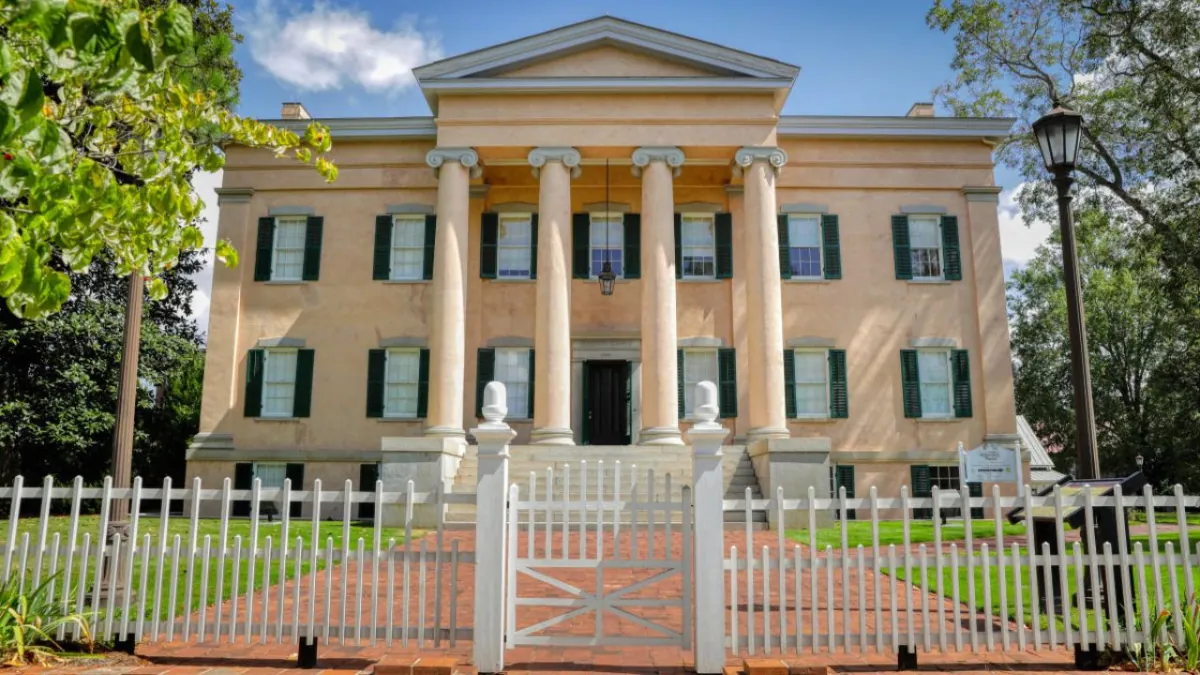The Old Governor’s Mansion in Milledgeville is one of the most exceptional landmarks of Georgia, brimming with historical and cultural significance. Built-in 1839, this grand edifice served as the official residence of eight governors until 1868, and it has borne witness to some of the most tumultuous events in the state’s history, including the Civil War and Reconstruction. Today, the mansion stands as a museum and a National Historic Landmark, proudly displaying the exquisite Greek Revival style of architecture and the artistry that went into its creation.
The Construction of the Mansion
In 1835, the Georgia legislature hired Charles B. Cluskey, an esteemed Irish architect known for his exceptional building designs in the antebellum South, to design the Old Governor’s Mansion. The mansion was constructed in 1839 and became the first official residence for the governor. The Old Governor’s Mansion was situated in Milledgeville, which served as the state capital from 1807 to 1868.
Back in the day, constructing the mansion was no small feat as it cost an impressive $60,000. The mansion was made of brick and stucco and boasted a beautiful portico with six Ionic columns, a symmetrical floor plan, and a central dome. The mansion was equipped with 30 rooms, including a grand staircase, a dining room, a drawing room, a library, and a ballroom.
In the 19th century, having an indoor plumbing system was considered a rare luxury, but the mansion had a sophisticated one. The mansion’s interior was adorned with opulent and costly furnishings, including mahogany furniture, marble mantels, crystal chandeliers, and silk curtains. The mansion’s exterior was graced by a formal garden, a carriage house, and a slave quarters.
The Governors Who Lived There
From 1839 to 1868, the Old Governor’s Mansion served as the residence of eight governors and their families. George R. Gilmer, who served as governor from 1839 to 1841, was the first to call it home. He was succeeded by Charles J. McDonald, George W. Crawford, George W. Towns, Howell Cobb, Herschel V. Johnson, Joseph E. Brown, and Thomas H. Ruger, each of whom also lived in the mansion during their time as governor.
The mansion bears the unique touch of each governor who resided there, as they added, modified, and personalized features to suit their individual preferences and requirements. Among the notable additions were the library and greenhouse, which were incorporated by Governor Crawford, while Governor Cobb introduced gas lighting and wallpaper. Governor Brown’s contributions included a fence and a fountain, enhancing the mansion’s overall appeal. Over the years, the mansion served as an esteemed venue for hosting prominent guests, including President James K. Polk, General Robert E. Lee, and General William T. Sherman.
The Historic Events That Took Place There
During the Civil War and Reconstruction, the Old Governor’s Mansion played a pivotal role in shaping Georgia’s history. It was witness to numerous historic events, including political debates, social gatherings, and military strategies. The mansion suffered damages and faced threats during the war, with General Sherman capturing Milledgeville in 1864 and occupying the mansion for two days. Despite the challenges, the mansion remained an important symbol of the state’s rich cultural heritage.
Although he refrained from burning down the mansion, he did vandalize and loot some of its contents. Additionally, he organized a fake legislative session inside the mansion, during which he and his officers pretended to reverse Georgia’s secession from the Union. Following the Civil War, the mansion served as the headquarters for Thomas H. Ruger, the federal military governor who supervised Georgia’s reconstruction. However, Ruger was the final governor to reside in the mansion, as the state capital was relocated to Atlanta in 1868.
The Preservation and Restoration of the Mansion
Once the state capital shifted to Atlanta, Georgia Military College acquired the Old Governor’s Mansion and repurposed it as a classroom, dormitory, and administrative building. The college valiantly maintained the mansion and its surrounding grounds, ensuring that no significant alterations or demolitions were made. The mansion’s historical significance was recognized in 1967 when it was designated as a National Historic Landmark. Later, in 1973, it was opened to the public and converted into a museum.
The mansion’s original furnishings and artifacts are on display at the museum, along with exhibits and programs that recount the mansion’s history and the lives of its inhabitants. The museum underwent an extensive restoration project between 2001 and 2004, which successfully restored the mansion to its original appearance and condition. The restoration project received numerous accolades and recognition for its precision and excellence.
The Conclusion
The Old Governor’s Mansion, located in Milledgeville, has been standing for over a century and remains as stunning as when it was first constructed. This magnificent building is a tribute to Georgia’s rich history and culture, displaying the Greek Revival architectural style. Moreover, it stands as a witness to the lives and experiences of the governors who resided there, facing various struggles and transformations throughout time. The mansion is a valuable treasure that has been carefully preserved and renovated to enlighten and entertain visitors. Thus, it is an excellent destination for those who admire history and appreciate beauty.
Also Read:
- This Hawaii City Is Ranked As One Of The Most Beautiful Cities In America
- This Georgia City Is Ranked As One Of The Most Beautiful Cities In America
- This City Has Been Named the Poorest in Idaho



